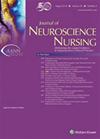欧洲卒中单元和非卒中单元医院的发热、高血糖和吞咽管理:欧洲急性卒中护理质量(QASC)子研究
IF 2
3区 医学
Q4 CLINICAL NEUROLOGY
引用次数: 0
摘要
背景:卒中单元护理降低患者发病率和死亡率。欧洲急性卒中护理质量研究在17个欧洲国家的64家医院实现了护士发起的发热、高血糖(糖)和吞咽(FeSS)管理方案的重大大规模翻译。然而,并不是所有的医院都有中风科。我们的研究旨在比较卒中单位与非卒中单位医院的FeSS方案依从性。方法:一项观察性研究采用了欧洲急性卒中护理质量研究实施后的数据。医院分类使用4个基于证据的特征来定义卒中单位,这些特征收集自参与医院的组织调查。采用混合效应logistic回归,调整年龄、性别和美国国立卫生研究院卒中量表,研究卒中单位和非卒中单位医院间FeSS协议依从性的差异。结果:在提供组织数据的16个国家的56家医院中,34家(61%)符合所有4个卒中单元特征,提供了2871例患者中的1825例(64%)(卒中单元医院)的数据。其余22家医院(39%)中,17家(77%)符合4个卒中单元特征中的3个(非卒中单元医院)。有卒中科室的医院和没有卒中科室的医院在实施后发热依从性方面没有差异(卒中科室49% vs非卒中科室57%;优势比[OR], 0.400;95%置信区间[CI], 0.087-1.844;P = 0.240),高血糖(50%卒中单位vs 57%非卒中单位;或者,0.403;95% ci, 0.087-1.856;P = 0.243),吞咽(75%卒中单位vs 60%非卒中单位;或者,1.702;95% ci, 0.643-4.502;P = .284),或FeSS方案的总体依从性(36%卒中单位vs 36%非卒中单位;或者,0.466;95% ci, 0.106-2.043;P = .311)。结论:我们的研究结果表明,护士发起的FeSS协议可以在医院实施,而不考虑卒中单元的状态。这是值得注意的,因为没有卒中单位资源的医院可以照顾急性卒中患者,可能实施这些协议。需要进一步努力确保更好地遵守FeSS议定书。本文章由计算机程序翻译,如有差异,请以英文原文为准。
Fever, Hyperglycemia, and Swallowing Management in Stroke Unit and Non–Stroke-Unit European Hospitals: A Quality in Acute Stroke Care (QASC) Europe Substudy
BACKGROUND: Stroke unit care reduces patient morbidity and mortality. The Quality in Acute Stroke Care Europe Study achieved significant large-scale translation of nurse-initiated protocols to manage Fever, hyperglycemia (Sugar), and Swallowing (FeSS) in 64 hospitals across 17 European countries. However, not all hospitals had stroke units. Our study aimed to compare FeSS protocol adherence in stroke unit versus non–stroke-unit hospitals. METHODS: An observational study using Quality in Acute Stroke Care Europe Study postimplementation data was undertaken. Hospitals were categorized using 4 evidence-based characteristics for defining a stroke unit, collected from an organizational survey of participating hospitals. Differences in FeSS Protocol adherence between stroke unit and non–stroke-unit hospitals were investigated using mixed-effects logistic regression, adjusting for age, sex, and National Institutes of Health Stroke Scale. RESULTS: Of the 56 hospitals from 16 countries providing organizational data, 34 (61%) met all 4 stroke unit characteristics, contributing data for 1825 of 2871 patients (64%) (stroke unit hospitals). Of the remaining 22 hospitals (39%), 17 (77%) met 3 of the 4 stroke unit characteristics (non–stroke-unit hospitals). There were no differences between hospitals with a stroke unit and those without for postimplementation adherence to fever (49% stroke unit vs 57% non–stroke unit; odds ratio [OR], 0.400; 95% confidence interval [CI], 0.087-1.844; P = .240), hyperglycemia (50% stroke unit vs 57% non–stroke unit; OR, 0.403; 95% CI, 0.087-1.856; P = .243), swallowing (75% stroke unit vs 60% non–stroke unit; OR, 1.702; 95% CI, 0.643-4.502; P = .284), or overall FeSS Protocol adherence (36% stroke unit vs 36% non–stroke unit; OR, 0.466; 95% CI, 0.106-2.043; P = .311). CONCLUSION: Our results demonstrate that the nurse-initiated FeSS Protocols can be implemented by hospitals regardless of stroke unit status. This is noteworthy because hospitals without stroke unit resources that care for acute stroke patients can potentially implement these protocols. Further effort is needed to ensure better adherence to the FeSS Protocols.
求助全文
通过发布文献求助,成功后即可免费获取论文全文。
去求助
来源期刊

Journal of Neuroscience Nursing
CLINICAL NEUROLOGY-NURSING
CiteScore
3.10
自引率
30.40%
发文量
110
审稿时长
>12 weeks
期刊介绍:
The Journal of Neuroscience Nursing (JNN), the official journal of the American Association of Neuroscience Nurses, contains original articles on advances in neurosurgical and neurological techniques as they affect nursing care, theory and research, as well as commentary on the roles of the neuroscience nurse in the health care team.
The journal provides information to nurses and health care professionals working in diverse areas of neuroscience patient care such as multi-specialty and neuroscience intensive care units, general neuroscience units, combination units (neuro/ortho, neuromuscular/rehabilitation, neuropsychiatry, neurogerontology), rehabilitation units, medical-surgical units, pediatric units, emergency and trauma departments, and surgery. The information is applicable to professionals working in clinical, research, administrative, and educational settings.
 求助内容:
求助内容: 应助结果提醒方式:
应助结果提醒方式:


